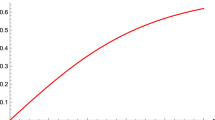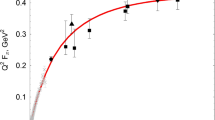Abstract
A field model for a quark and an antiquark binding is described. Quarks interact via a gauge unparticle (“ungluon”). The model is formulated in terms of Lagrangian which features the source field S(x) which becomes a local pseudo-Goldstone field of conformal symmetry — the pseudodilaton mode and from which the gauge non-primary unparticle field is derived by B μ(x) ∼ ∂μ S(x). Because the conformal sector is strongly coupled, the mode S(x) may be one of new states accessible at high energies. We have carried out an analysis of the important quantity that enters in the “ungluon” exchange pattern — the “ungluon” propagator.
Similar content being viewed by others
References
H. Georgi, Phys. Rev. Lett. 98, 221601 (2007); Phys. Lett. B 650, 275 (2007).
H. Goldberg and P. Nath, Phys. Rev. Lett. 100, 031803 (2008); T. Kikuchi and N. Okada, Phys. Lett. B. 661, 360 (2008); B. Grinstein, K. Intriligator, and I. Z. Rothstein, Phys. Lett. B 662, 367 (2008); K. Cheung et al., Phys. Lett. B 662, 436 (2008); P. Gaete and E. Spalluci, Phys. Lett. B 668, 336 (2008); M. Neubert, Phys. Lett. B 660, 592 (2008); F. Sannino and R. Zwicky, Phys. Rev. D 79, 015016 (2009); A. Delgado et al., Phys. Rev. D: Part. Fields 79, 055011 (2009).
M. A. Stephanov, Phys. Rev. D: Part. Fields 76, 035008 (2007).
N. V. Krasnikov, Int. J. Mod. Phys. A 22, 5117 (2007).
J. R. Ellis, Nucl. Phys. B 22, 478 (1970); R. J. Crewther, Phys. Lett. B 33, 305 (1970); M. S. Chanowitz and J. R. Ellis, Phys. Lett. B 40, 397 (1972); J. C. Collins, A. Duncan, and S. D. Joglekar, Phys. Rev. D 16, 438 (1977); N. K. Nielsen, Nucl. Phys. B 120, 212 (1977); J. Schechter, Phys. Rev. D: Part. Fields 21, 3393 (1980).
T. Banks and A. Zaks, Nucl. Phys. B 196, 189 (1982).
A. A. Migdal and M. A. Shifman, Phys. Lett. B 114, 445 (1982).
E. Gildener and S. Weinberg, Phys. Rev. D: Part. Fields 13, 3333 (1976).
W. D. Goldberger, B. Grinstein, and W. Skiba, Phys. Rev. Lett. 100, 111802 (2008).
R. J. Riebert, Phys. Lett. B 134,56 (1984); E. S. Fradkin and A. Tseitlin, Phys. Lett. B 134, 187 (1984).
R. Ferrari, Nuovo Cim. A 19, 204 (1974).
D. Zwanziger, Phys. Rev. D: Part. Fields 17, 457 (1978).
E. d’Emilio and M. Mintchev, “A Gauge Model with Perturbative Confinement in Four Dimensions,” Report IFUP 1979 (Pisa, unpublished); E. d’Emilio and M. Mintchev, Phys. Lett. B 89, 207 (1980).
G. A. Kozlov and A. Baldicchi, New J. Phys. 4, 16.1 (2002).
G. A. Kozlov, “Gauge Model of Unparticles,” arXiv:0903.5252 [hep-ph].
N. N. Bogolyubov et al., General Principles of Quantum Field Theory (Nauka, Moscow, 1987) [in Russian].
Author information
Authors and Affiliations
Additional information
The article is published in the original.
Rights and permissions
About this article
Cite this article
Kozlov, G.A. The gauge unparticles (“ungluons”). Phys. Part. Nuclei 41, 957–961 (2010). https://doi.org/10.1134/S1063779610060298
Published:
Issue Date:
DOI: https://doi.org/10.1134/S1063779610060298




